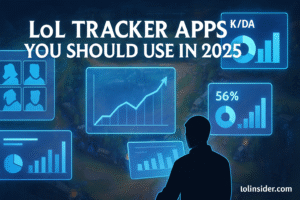League of Legends (LoL) is a game of strategy, mechanics, and quick decision-making. While flashy plays and high KDA scores get the spotlight, map awareness is the hidden skill that separates average players from climbing-ranked veterans. Knowing when to rotate, where enemies might be, and how to prevent ganks often determines victory long before the late-game teamfights.
In this article, we’ll dive into what map awareness truly means, why it’s vital for improving at League of Legends, and actionable techniques you can use to train your minimap habits, improve vision control, and anticipate enemy movements like a pro.
What is Map Awareness?
Map awareness in League of Legends refers to your ability to process information from the minimap and translate it into smart decisions. It’s not just about looking at the minimap—it’s about understanding what you see and predicting what might happen next.
Key aspects include:
- Tracking enemy positions: Knowing where enemies are and where they might be.
- Reading vision control: Understanding which areas are safe or dangerous.
- Predicting rotations: Guessing the enemy’s next moves based on objectives and lane states.
- Communicating information: Using pings effectively to help your teammates act on map awareness.
Why Map Awareness Wins Games
Even with perfect mechanics, poor map awareness often leads to throwing games. Here’s why it’s so impactful:
- Prevents Deaths – Most deaths come from a lack of awareness, such as pushing too far without knowing where the jungler is.
- Enables Plays – Great map awareness lets you roam mid as a top laner, collapse on fights earlier, or secure objectives uncontested.
- Objective Control – Map awareness keeps you aligned with dragon, Rift Herald, and Baron spawns.
- Macro Advantage – Teams with better vision and rotations consistently out-macro opponents, creating inevitable leads.
Simply put: better map awareness = fewer mistakes + more opportunities.
Building Good Minimap Habits
Improving map awareness starts with consistent minimap checks. The best players don’t just glance occasionally—they build a rhythm of map scanning into their gameplay.
1. The “Every 5 Seconds Rule”
A common coaching tip is: look at the minimap every 5 seconds or after every action. This could mean after last-hitting a minion, trading with your lane opponent, or using a skill.
2. Peripheral Awareness
Train your peripheral vision to notice minimap pings, missing champion icons, and vision wards disappearing without needing to stare directly at it.
3. Tie it to Cooldowns
Another method is connecting minimap checks with cooldowns. For example:
- Every time your Q is on cooldown, glance at the minimap.
- After placing a ward, scan the minimap to see if enemies show up on it.
4. Watch the Waves
Minimap wave management tells you:
- Where fights might break out.
- Which tower is under pressure.
- If a side lane is slow pushing into your tower.
Vision Control and Warding
Vision is the foundation of map awareness. Without information, you’re just guessing.
1. Control Wards
Control wards should always be used to secure high-traffic areas like:
- Dragon and Baron pits.
- River bushes near mid.
- Tri-bushes in bot and top lanes.
2. Trinkets
- Yellow Trinket (Stealth Ward): Best early for laning phase to track jungle paths.
- Oracle Lens: Essential mid-to-late game for sweeping enemy wards and preparing objectives.
- Farsight Alteration: Great for ADCs or mages in late-game to scout safely from a distance.
3. Common Vision Mistakes
- Warding too deep alone and dying for it.
- Not refreshing expired wards when trinkets are available.
- Clumping all vision in one spot instead of spreading it.
Tip: Always place wards with a purpose. If dragon is up in 1 minute, vision should focus around river and bot side—not random jungle camps.
Reading the Enemy Jungler
The jungler is often the biggest threat to your lane, so tracking them boosts map awareness tremendously.
How to Track:
- Jungle Start Clues: If bot lane arrives late, jungler started bot.
- Buff Timings: First buff spawns at 1:30, respawns every 5 minutes.
- Scuttle Fights: Expect junglers around river at 3:15.
- Gank Angles: Know common paths—tri-bush, river bush, and lane ganks.
Once you track the jungler, you can predict:
- Which lane is at risk.
- Whether you can play aggressively.
- If an objective is contested.
Rotations and Map Plays
Map awareness isn’t just defensive—it also creates opportunities to win.
1. Roaming
Mid laners and supports benefit the most from roaming. But roaming blindly without map awareness wastes time. Always check:
- Is the wave pushed?
- Is the enemy missing from lane?
- Do you have vision in river or jungle?
2. Objective Timers
Smart players track dragon, Herald, and Baron timers. Arriving 30–40 seconds early to set up vision almost guarantees control.
3. Cross-Map Plays
When enemies commit multiple players to one side, punish with a play elsewhere. For example:
- Enemy dives top lane → take dragon bot.
- Enemy starts Baron → push mid inhib tower.
Using Pings to Amplify Map Awareness
You can’t just see the map—you must communicate it. Pings are the universal language in LoL.
Types of useful pings:
- Danger Ping: Warns allies of threats.
- On My Way: Signals rotations and engages.
- Assist Me: Calls for backup around objectives.
- Vision Pings: Marks wards or dark areas.
Pro tip: Don’t spam useless pings. One well-timed danger ping is more effective than 10 random ones.
Training Map Awareness Outside of Games
You can sharpen your map awareness even without grinding ranked.
- Replay Reviews – Watch your deaths and ask: Did I check the minimap before this?
- Pro VODs – Observe how often pros look at the minimap compared to their actions.
- Custom Games – Practice warding patterns and jungle tracking without pressure.
- Streamer Habits – Good streamers explain map reads out loud—try to follow their logic.
Advanced Map Awareness Concepts
1. Fog of War Manipulation
Understand where enemies are likely hiding even if you don’t see them. Use common sense and timings.
2. Lane Priority
Who has shove priority determines who can rotate first. Track enemy wave states through the minimap to avoid being late to fights.
3. Win Condition Tracking
Map awareness also means tracking who’s fed and playing around them. Always know if it’s your ADC, jungler, or mid laner carrying.
4. Tempo Advantage
If your team recalls earlier, you can push vision while the enemy is resetting. That window is map awareness at work.
Common Map Awareness Mistakes
- Tunnel Vision: Focusing only on CSing or fighting without checking the minimap.
- Late Rotations: Not reacting until it’s too late.
- Ignoring Objectives: Fighting when dragon is spawning leads to wasted opportunities.
- No Vision Setup: Walking blind into fog without sweepers or wards.
Step-by-Step Training Plan
- Week 1: Commit to minimap checks every 5 seconds.
- Week 2: Add jungle tracking and write down spawn timers.
- Week 3: Focus on pings—warn teammates consistently.
- Week 4: Review replays and eliminate tunnel vision deaths.
By the end of a month, your map awareness will feel natural rather than forced.
Conclusion
Mastering map awareness in League of Legends is one of the fastest ways to climb. It doesn’t require insane mechanics, only discipline, habit-building, and game knowledge.
When you consistently track the minimap, communicate with pings, and understand rotations, you’ll die less, secure more objectives, and win more games. Map awareness is the invisible stat that turns good players into great ones.
So the next time you load onto Summoner’s Rift, remember: your minimap is your sixth teammate.







